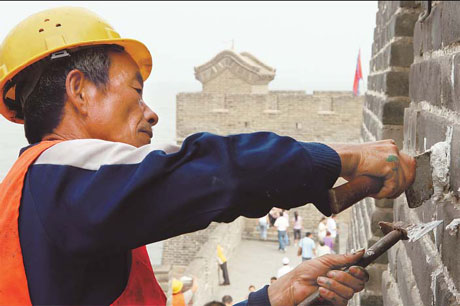Time travel
|
|
|
A young performer, posing as a statue of an ancient official, draws the attention of visitors to Shanhaiguan that sits at the easternmost end of the Great Wall. Photos by Xu Jingxing / China Daily |
|
|
|
A band of elderly men playing music on the streets of Shanhaiguan. |
|
|
|
A kung fu master practicing his moves at the Shanhai Pass of Great Wall |
The Shanhai Pass of the Great Wall in Hebei province is the perfect place to catch a glimpse of life in China some 600 years ago.?
The place where the Great Wall meets the Pacific Ocean at its eastern end is a stunning sight that draws millions of tourists today.
|
|
|
Maintenance work on the "Old Dragon Head", the part of the Great Wall which enters the Bohai Sea. |
Many camp here overnight to catch the breathtaking view of the first rays of the sun kissing the soaring ramparts of its watchtowers and coating the blue waters of the Bohai sea with a golden hue.
But it presented a very different picture a decade ago, as backpacker Guo Qingyang from Shandong province will attest.
A frequent visitor to the Shanhai Pass (Shanhaiguan), located in Hebei province, Guo, 70, has witnessed the dramatic changes to the 600-year-old site, called the "No 1 Fortress under the Sky".
|
|
|
Hou Dakun (middle) and Yang Yeming are one of many young couples who hold their weddings in the traditional courtyard houses. |
Stretching from west to east through several northern China provinces, the Great Wall was first built during the Qin Dynasty (221-206 BC), with successive dynasties rebuilding the parts destroyed in wars and adding their own to its length.
The sections in today's Hebei province, including the Shanhai Pass, were rebuilt during the Ming Dynasty (1368-1644).
The Pass, that sits between the sea and the Yanshan Mountains, was one of the first cultural heritage sites to be put under State protection in the early 1980s.
Miraculously, the original layout of the Ming Dynasty town of Shanhai is largely intact, experts say.
The town boasts more than 60 cultural heritage sites ranging from official residences, military offices, temples, old family houses, and more than 20 archways.
However, when Guo first visited this coastal town what he saw were big holes in the walls of the fortress and its auxiliary structures, collapsed watchtowers, and rain-eroded surfaces.
A number of the original bricks had been carted away and used by the locals to build their houses and even chicken coops and pig sties.
In 1984, when late Chinese leader Deng Xiaopeng visited the Badaling section of the Great Wall in Beijing, he called for joint efforts from all walks of society to help preserve the Great Wall, calling the ancient structure a symbol of an undefeatable Chinese nation.
In 1985, Ruan Yisan and Zhou Jian, both architecture professors with Shanghai Tongji University, submitted a master plan for upgrading a 190-sq-km area surrounding the Shanhai Pass.
The plan was only put into action in late 2003, with the support of both the central and local governments.
Since then, 51 specific projects, involving an investment of some 600 million yuan ($88.1 million), have been implemented to renovate this section of the Great Wall, according to Song Guozhan, director of Shanhai Pass Ancient Town Management Board.
They include the refurbishment of a drum tower and a bell tower in the central part of the old town, a south watchtower, a west watchtower, five archways and several Taoist and Buddhist temples, according to Song.

A further one billion yuan has been poured into the four main streets stretching south, west, north and east of the town; Ming-style shops, markets and other public spaces have all been renovated.
Nine years of efforts are finally paying off with the renovated parts of the Pass packing in tourists.
Locals too are flocking to the Wall for their morning exercises or simply for a stroll. The area has emerged as the place of choice for street shows of song and dance, or peaceful moments in the nearby restaurants, cafes, teahouses and galleries.
Young couples come here for photo-shoots in old-style courtyards.
"It is a historical responsibility of our people and our government to keep the Shanhai Pass safe and pass it on to future generations," said Li Changchun, a member of the Standing Committee of the Communist Party of China (CPC) Central Committee Political Bureau, during a recent trip to the newly renovated fortress.
The renovation will also boost the local economy, said Li who has been closely involved in the process since his first visit to the Pass in 2006.
 0
0 












